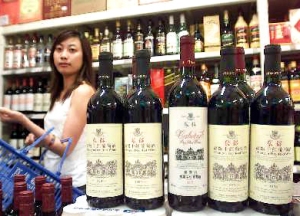The average Chinese consumer is unfamiliar with the different types of wine available and better consumer education and brand awareness is needed for imported wine to successfully penetrate the Chinese market. Overall, Chinese consumers are price sensitive and prefer to purchase local or regional brands. Wine consumption is normally reserved for special occasions and imported premium wines are available mainly in restaurants catering to foreigners or expatriates. Some large Chinese seafood restaurants have begun offering wine for on-trade consumption.
Premium products cater more to well-off individuals who want to display their wealth. High-end products, such as premium wine and champagne, are more likely to be purchased as gift items rather than for personal consumption; overall sales remain modest due to high prices.
Red wine has become particularly popular in China, due to its perceived health benefits in addition to the fact that it is more heavily produced and promoted by a wide range of domestic and multinational manufacturers. The colour red also signifies good luck and happiness in China which has helped sales. This has caused many Chinese consumers to be more familiar with red grape wines, such as Merlot and Cabernet Sauvignon, rather than white grape wines.
Prohibitive pricing continues to keep grape wine sales modest. Demand is fuelled by residing foreigners and expatriates, although rising consumer awareness and sophistication has been a key driving factor in the spike in grape wine sales recently seen in China.
Competitors
Due to insufficient domestic grape production, Chinese wine makers often import grapes and bulk wine to blend with local wine. Chinese wine faces severe criticism from wine experts around the world due to its poor quality and taste. There are around 500 small wineries in China, producing wine grapes of varying quality. Leading wine producers include Great Wall, Changyu, Tonghua and Dynasty. Together they make up approximately 60% of the wine market. Less well known brands include Remy Cointreau, Yantai Weilong Grape Wine, Shengda Wine, Dragon Seal, and Suntime. Dominant local players have well established distribution networks, although they may be confined to a specific region.
Distribution
Potential importers can seek to have their goods distributed in four ways: firstly, through contacting a retailer directly; secondly, through an agent; thirdly, through a wholesaler/distributor; and fourthly, through a wholesale mart. Most foreign/imported wines are consumed in high-end restaurants but supermarkets are increasingly located where middle- and high-income consumers go to buy their groceries.
 Barriers to Entry
Barriers to Entry
Tariffs on imported foreign alcohol range from 10% to 30%. Bottled wine faces tariffs of around 12% to 14%, while wine in bulk faces tariffs of around 20%. These tariffs, combined with the 10% Consumption Tax Rate (CTR) and 17% Value Added Tax (VAT), result in an overall tax of around 50% of the product’s value.
Standards for wine fall under the responsibility of the Administration of Quality Supervision, Inspection and Quarantine (AQSIQ).
Some standards that apply to wine:
Standards for the Administration of Wholesaling of Alcoholic Products
Standards for Administration of Retailing of Alcoholic Products
Measures for the Administration of Wine Distribution
Hygiene Standards of Distilled and Brewed Wine





Muchas gracias,muy informativo
Que buen articulo, como el de Japon. Super útiles, Muchas gracias.
Gran ayuda.
Dominio por tu parte
Carlos
That is a good post, good information, really good market research
Thank you very much
Lukas